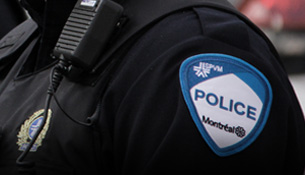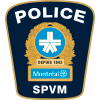Cavalry
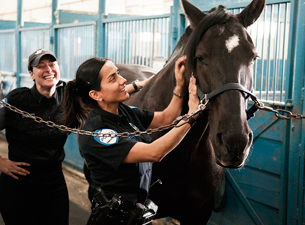 The cavalry is an important aspect of police presence throughout Service de police de la Ville de Montréal (SPVM) territory, because it provides police patrol and visibility in places that would otherwise be difficult to access.
The cavalry is an important aspect of police presence throughout Service de police de la Ville de Montréal (SPVM) territory, because it provides police patrol and visibility in places that would otherwise be difficult to access.
Description of the unit
The cavalry unit of the Service de police de la Ville de Montréal (SPVM) includes:
- 8 horses
- 10 officers
- 3 civilian employees (grooms) who take care of the horses and maintain the stables on a daily basis
The riders are divided into 3 work groups of 3 riders. There are 2 work shifts, alternating day and night.
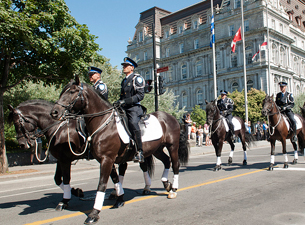 Roles and responsibilities of the cavalry
Roles and responsibilities of the cavalry
- Give priority response to the needs of SPVM neighbourhood stations (e.g., searches, disappearances, open houses, special events such as parades, Saint-Jean-Baptiste celebration, Civic ceremonies,Montréal Grand Prix)
- Enforce municipal laws and regulations
- Prevent crime
- Patrol the territory of the Island of Montréal, in the parks and other areas not accessible to police vehicles
- Resolve problems related to parks, cycling paths, and green spaces
- Explain the role of the cavalry during school visits or presentations
- Participate in crowd control at events or demonstrations
Services offered
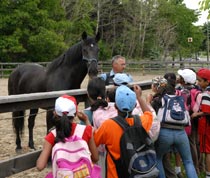
Services for hire
It is possible to hire the cavalry for:
- escorting dignitaries
- patrolling parks or other outdoor spaces
- taking part in parades, ceremonies, private celebrations and weddings.
For more information, please contact the SPVM Business services team.
History
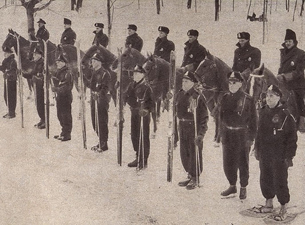
The cavalry was created in 1885. At that time, it had 6 riders and the stables were located on the corner of Rachel and Christophe-Colomb.
Its role was to:
- patrol public places such as Mont-Royal park, Fletcher’s Field, avenue des Pins and chemin Papineau
- act as a Pony Express, ensuring rapid connection and fast delivery of messages between the various police stations
- enforce municipal speed regulations (bicycles and cars: maximum of 6 miles an hour)
1940s
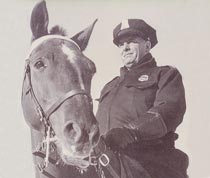 In 1947, downtown Montréal was suffering from serious traffic problems. Mr. Langlois, the police director at that time, decided to assign cavalry patrollers from across the territory to the downtown sector, and the exercise was a complete success. In 1948, the cavalry was incorporated into the traffic control service.
In 1947, downtown Montréal was suffering from serious traffic problems. Mr. Langlois, the police director at that time, decided to assign cavalry patrollers from across the territory to the downtown sector, and the exercise was a complete success. In 1948, the cavalry was incorporated into the traffic control service.
1950s
The cavalry boasted its greatest number of riders around 1950, with 45 horses. Of these, 30 were assigned to traffic downtown and 15 patrolled the parks (such as Mont-Royal, Jarry, and Île Sainte-Hélène). They participated in parades and sometimes in
civic funerals.
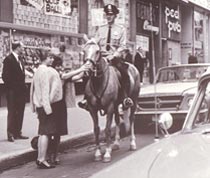
In 1955, the cavalry stopped patrolling the downtown area and 17 horses were sold. The 24 remaining horses worked in the parks.
1960s
Then in 1962, the stables on Mount Royal were built and the cavalry acquired its first Palomino, the breed that the cavalry would favour for the next 20 years. In 1995 another breed was adopted – the Canadian Horse, which is much more robust and better suited to the patrollers’ needs.
1980s
In the following years, the number of horses in the service fluctuated as different directors took charge of the police service. In 1981, when a woman named Hurteau gathered 140,000 signatures on a petition to keep the cavalry in service, a report was ordered to assess the value of maintaining the team. The directors came to the conclusion that the cavalry was still the safest and most effective way to patrol Montréal’s green spaces.
Today
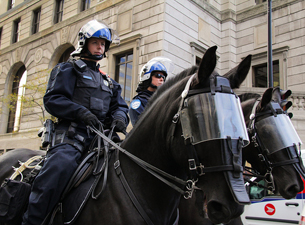 Today we can still count on the cavalry to patrol the streets of Montréal, to maintain police presence in our parks and to increase our citizens’ sense of security.
Today we can still count on the cavalry to patrol the streets of Montréal, to maintain police presence in our parks and to increase our citizens’ sense of security.

